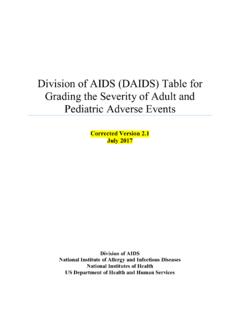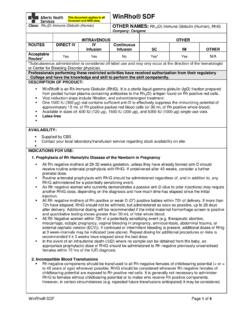Transcription of Division of AIDS (DAIDS) Table for Grading the Severity of ...
1 Division of AIDS (DAIDS) Table for Grading the Severity of Adult and Pediatric Adverse Events Corrected Version July 2017. Division of AIDS. National Institute of Allergy and Infectious Diseases National Institutes of Health US Department of Health and Human Services Table of Contents Glossary and Acronyms .. 1. Introduction .. 3. Instructions for Use .. 4. Major Clinical Conditions .. 7. Cardiovascular .. 7. Dermatologic .. 9. Endocrine and Metabolic .. 10. Gastrointestinal .. 12. Musculoskeletal .. 14. 15. Pregnancy, Puerperium, and Perinatal .. 17. Psychiatric .. 18. Respiratory .. 19. Sensory .. 20. Systemic .. 21. Urinary .. 23. Site Reactions to Injections and Infusions .. 24. Laboratory Values .. 25. Chemistries .. 25. Hematology .. 29. Urinalysis .. 31. Appendix A. Total Bilirubin Table for Term and Preterm Neonates.
2 32. Glossary and Acronyms AE Adverse event; Any unfavorable and unintended sign (including an abnormal laboratory finding), symptom, or disease temporally associated with the use of a medical treatment or procedure regardless of whether it is considered related to the medical treatment or procedure. ALT (SGPT) Alanine aminotransferase (serum glutamic pyruvic transaminase). ANC Absolute neutrophil count AST (SGOT) Aspartate aminotransferase (serum glutamic-oxaloacetic transaminase). AV Atrioventricular Basic Self-care Functions Adult Activities such as bathing, dressing, toileting, transfer or movement, continence, and feeding. Young Children Activities that are age and culturally appropriate, such as feeding one's self with culturally appropriate eating implements. BMI z-score Body mass index z- score; A body reference norm.
3 Specifically, the number of standard deviations a participant's BMI differs from the average BMI for their age, sex, and ethnicity. BMD t-score Bone mineral density t-score; The number of standard deviations above or below the mean bone mineral density of a healthy 30 year old adult of the same sex and ethnicity as the participant. BMD z-score Bone mineral density z-score; The number of standard deviations a participant's BMD differs from the average BMD for their age, sex, and ethnicity. BPAP Bilevel positive airway pressure; A mode used during noninvasive positive pressure ventilation. Chemical Pregnancy A pregnancy in which a positive pregnancy test is followed by a negative pregnancy test without evidence of a clinical pregnancy loss. CNS Central nervous system CPAP Continuous positive airway pressure DAERS DAIDS Adverse Experience Reporting System; An internet-based system developed for clinical research sites to report Expedited Adverse Events (EAEs) to DAIDS.
4 It facilitates timely EAE report submission and serves as a centralized location for accessing and processing EAE information for reporting purposes. Disability A substantial disruption of a person's ability to conduct normal life functions. ECG Electrocardiogram eGFR Estimated glomerular filtration rate Hospitalization Does not include the following hospital admissions: under 24 hours, unrelated to an adverse event ( , for labor and delivery, cosmetic surgery, social or administrative for temporary placement [for lack of a place to sleep]), protocol-specified, and for diagnosis or therapy of a condition that existed before the receipt of a study agent and which has not increased in Severity or frequency. INR International normalized ratio DAIDS AE Grading Table Corrected Version 2017. Page 1. Glossary and Acronyms Intervention Medical, surgical, or other procedures recommended or provided by a healthcare professional for the treatment of an adverse event.
5 IV intravenous ivig intravenous immune globulin LDL Low density lipoprotein LLN Lower limit of normal Life-threatening AE Any adverse event that places the participant, in the view of the investigator, at immediate risk of death from the reaction when it occurred ( , it does not include a reaction that would have caused death if it had occurred in a more severe form). NA Not applicable Participant ID The identification number assigned to a study participant which is used to track study-related documentation, including any reported AEs. PR Interval The interval between the beginning of the P wave and the beginning of the QRS complex of an electrocardiogram that represents the time between the beginning of the contraction of the atria and the beginning of the contraction of the ventricles. PT Prothrombin time PTT Partial thromboplastin time QTc Interval The measure of time between the onset of ventricular depolarization and completion of ventricular repolarization corrected for ventricular rate.
6 RBC Red blood cell SI Standard international unit ULN Upper limit of normal Usual Social & Functional Activities Activities which adults and children perform on a routine basis and those which are part of regular activities of daily living, for example: Adults Adaptive tasks and desirable activities, such as going to work, shopping, cooking, use of transportation, or pursuing a hobby. Young Children Activities that are age and culturally appropriate, such as social interactions, play activities, or learning tasks. WBC White blood cell WHO World Health Organization WNL Within normal limits DAIDS AE Grading Table Corrected Version July 2017. Page 2. Introduction The Division of AIDS (DAIDS) oversees more than 300 clinical trials domestically and internationally, which evaluate the safety and efficacy of therapeutic products, vaccines, and other preventive modalities.
7 Adverse event (AE) data collected during these clinical trials form the basis for subsequent safety and efficacy analyses of pharmaceutical products and medical devices. Incorrect and inconsistent AE Severity Grading can lead to inaccurate data analyses and interpretation, which in turn can impact the safety and well-being of clinical trial participants and future patients using pharmaceutical products. Over the years, DAIDS scientific knowledge and experience have expanded, necessitating revisions of the DAIDS Grading Table which serves as a guide for assessing the Severity of AEs (including clinical and laboratory abnormalities) in participants enrolled in DAIDS-sponsored and -supported clinical trials. The Division of AIDS (DAIDS) Table for Grading the Severity of Adult and Pediatric Adverse Events, Corrected Version (July 2017) updates and replaces version (March 2017).
8 DAIDS is grateful to the DAIDS Grading Table Working Group, numerous government and non-government affiliated medical subject matter experts and reviewers who were instrumental in the revision of the DAIDS Grading Table . DAIDS AE Grading Table Corrected Version 2017. Page 3. Instructions for Use General Considerations The Division of AIDS (DAIDS) Table for Grading the Severity of Adult and Pediatric Adverse Events, Version consists of parameters, or AEs, with Severity Grading guidance that are to be used in DAIDS clinical trials for safety data reporting to maintain accuracy and consistency in the evaluation of AEs. The term severe is not the same as the term serious in classifying AEs. The Severity of a specific event describes its intensity, and it is the intensity which is graded. Seriousness, which is not graded, relates to an outcome of an AE and is a regulatory definition.
9 Clinical sites are encouraged to report parameters in the DAIDS Grading Table as they are written to maintain data consistency across clinical trials. However, since some parameters can be reported with more specificity, clinical sites are encouraged to report parameters that convey additional clinical information. For example, diarrhea could be reported as neonatal diarrhea;. seizures, as febrile seizures; and pain, as jaw pain. The DAIDS Grading Table provides an AE Severity Grading scale ranging from grades 1 to 5 with descriptions for each AE based on the following general guidelines: Grade 1 indicates a mild event Grade 2 indicates a moderate event Grade 3 indicates a severe event Grade 4 indicates a potentially life-threatening event Grade 5 indicates death (Note: This grade is not specifically listed on each page of the Grading Table ).
10 Other points to consider include: Use age and sex values as applicable. Unless noted, laboratory values are for term neonates. Preterm neonates should be assessed using local laboratory normal ranges. Where applicable, Standard International (SI) units are included in italics. Selecting and Reporting a Primary AE Term When selecting a primary AE term to report, sites should select the term that best describes what occurred to the participant. For example, a participant may present with itching, urticaria, flushing, angioedema of the face, and dyspnea. If the underlying diagnosis is determined to be an acute allergic reaction, sites should report Acute Allergic Reaction as the primary AE term. Primary AE terms should be reported using the DAIDS Adverse Experience Reporting System (DAERS) only if they meet expedited reporting criteria.




